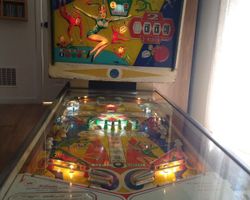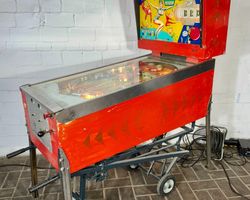Jumpin' Jack's

Average Prices: USD $300 to $700
Produced: April, 1963
Production Run: 1,500 units
Machine Type: Electro-mechanical
Players: 2
Design by: Steve Kordek
"Jumpin' Jack's," an electro-mechanical (EM) pinball machine, emerged from the Williams Electronic Games, Inc. factory in April 1963. Bearing the model number 280, this two-player game represents a period of significant innovation in pinball design. Production figures indicate that 1,500 units were manufactured, with 855 designated for the USA and Canadian markets and 645 for export, offered to distributors at a price of $397.50. The machine's creation was a collaborative effort, with Steve Kordek responsible for its design and George Molentin credited for the distinctive artwork. The overarching theme of "Jumpin' Jack's" leans into the whimsical world of circus and carnival, aiming to evoke a sense of lightheartedness and joy through its visual presentation.
Signature Features and Design
"Jumpin' Jack's" distinguishes itself through a suite of features that define its gameplay and aesthetic. Central to its unique character are the two gobble holes, each cleverly protected by a drop target. This innovative design element, a hallmark of the machine, transforms what could be a simple ball drain into a strategic choice. Instead of passively losing a ball, players must actively engage with the drop targets to either open access to the high-scoring gobble holes or attempt to bypass them to maintain ball control. Beyond these, the machine incorporates two flippers, three pop bumpers, two passive bumpers, two slingshots, and five rollover buttons, all contributing to the machine's interactive potential. The auditory experience is provided by two bells and a knocker, classic EM sounds that punctuate gameplay actions.
The artwork by George Molentin is a notable element of "Jumpin' Jack's," often described as a "surreal joke" or a "circus troupe" theme. Players encounter characters that appear as people in bunny suits cavorting alongside "balloon-headed elves." This visual style has drawn varied responses, with some finding it odd yet amusing, contributing to the machine's eccentric charm, while others perceive it as less appealing. Regardless of individual preference, the art package undeniably imbues "Jumpin' Jack's" with a unique visual identity that stands apart.
Playfield and Mechanics
The playfield of "Jumpin' Jack's" is meticulously structured, encouraging a dynamic and strategic game flow. The upper portion of the playfield provides limited scoring opportunities, typically offering 100 points or a chance to increase the gobble hole score. Critically, this upper area is designed so that a ball cannot be lost once it enters, allowing for a reprieve or a setup shot. The main attractions and higher scoring potential are concentrated in the lower half of the playfield, necessitating skillful shots to transition the ball between the upper and lower sections.
Key playfield elements include the aforementioned drop targets positioned to guard the two gobble holes. Successfully hitting a drop target opens access to a gobble hole, presenting a high-risk, high-reward shot. The skill shot, requiring precision to guide the ball into the top lane, adds an immediate challenge upon launch. Three fast-acting pop bumpers are situated at the top of the playfield, ensuring the ball maintains momentum and unpredictability in that zone. Two slingshots flank the bottom of the playfield, adding a responsive dynamic to the lower action. The two flippers, while described by some as smaller and contributing to a challenging control experience, are nonetheless potent enough to propel the ball across the playfield with force. The absence of traditional in-lanes often means more direct ball returns to the flippers, requiring quick reflexes. The overall aesthetic of the playfield is vibrant, with lighting used to highlight active targets and score milestones, consistent with the EM era's approach to visual feedback.
Gameplay Dynamics
The gameplay dynamics of "Jumpin' Jack's" revolve around a blend of skillful shot-making and calculated risk. The maximum displayed score for each player is 1,999 points, with the replay wheel maxing out at 47. The scoring system rewards accuracy in hitting targets and navigating the playfield. The central challenge lies in the strategic interaction with the gobble holes and their protecting drop targets. Players face a constant decision: risk a ball drain for substantial points by shooting for an open gobble hole, or play it safe, focusing on other targets to build score while keeping the ball in play. Hitting one drop target might open a gobble hole, but the game encourages further precision by often requiring another shot to truly capitalize on the opportunity or manage the risk.
The pacing of "Jumpin' Jack's" is often described as surprisingly fast, particularly in the lower half of the playfield where the main scoring opportunities reside. This quick action demands player agility and quick decision-making. A notable unique feature for multi-player games is an interesting bonus system that builds up and carries over to the next player. This mechanic adds an element of shared anticipation and competitive strategy, as players might benefit from the preceding player's efforts, or conversely, set up a lucrative bonus for their opponent. This blend of individual skill and inter-player dynamics makes "Jumpin' Jack's" a compelling experience for two players.
Reception and Legacy
"Jumpin' Jack's" generally garners a positive to slightly above-average sentiment within the pinball community. It is frequently described as a "nice," "fun," and "surprising" machine, offering a commendable amount of strategic depth for an EM title from its era. While it may not consistently rank among the very highest echelon of pinball machines for all collectors, its unique attributes ensure it holds a respected place.
The primary strengths of "Jumpin' Jack's" lie in its innovative gameplay mechanics. The use of drop targets to protect gobble holes was a forward-thinking design choice, allowing for a layer of player control over what would typically be an arbitrary ball-ending feature. This innovation is consistently highlighted as a significant contribution to pinball design. The fast-paced action, especially in the lower playfield, and the responsive nature of the pop bumpers in the upper section are also frequently praised. The carry-over bonus feature is seen as a clever addition that enhances the two-player experience. The challenging flipper control, attributed by some to their size and the lack of in-lanes, is viewed as a positive by those who appreciate a demanding game.
However, "Jumpin' Jack's" is not without its polarizing elements. The gobble holes, while central to the game's strategy, are also recognized as a quick way to lose a ball, which can frustrate some players. The concentration of high-scoring opportunities in the lower playfield means that the upper section, while important for ball management, can sometimes feel less rewarding. The art package, as previously noted, divides opinion, with some finding its surreal humor charming and others considering it aesthetically unappealing.
Despite these varied perspectives, "Jumpin' Jack's" secured its place in pinball history due to its inventive design choices. Steve Kordek's approach to integrating the drop targets with the gobble holes set a precedent for adding layers of decision-making to the playfield. This concept of player-controlled access to high-risk, high-reward areas influenced later machine designs, solidifying its significance as an early example of strategic depth in pinball. Its enduring appeal lies in its ability to offer an engaging and surprisingly challenging game that belies its 1963 origins, remaining a captivating experience for those who appreciate the foundational innovations of electro-mechanical pinball.
Sponsored Links
 Ebay Listings
Ebay Listings
 Auction Results
Auction Results
| Cost | Location | Date |
|---|---|---|
| EUR €700 |  Nordrhein-Westfalen, Germany Nordrhein-Westfalen, Germany |
03 July, 2025 |
| USD $225 |  United States United States |
31 March, 2024 |
| USD $550 |  Massachusetts, United States Massachusetts, United States |
15 January, 2017 |
| USD $301 |  New York, United States New York, United States |
05 January, 2016 |


Private Policy · Search Website · Contact Us
As an eBay Partner, we may earn a commission from qualifying purchases made through links on this site, at no additional cost to you.
All trademarks and copyrighted materials remain property of their respective owners. All other content copyright 2007 - 2025 Pinpedia.


